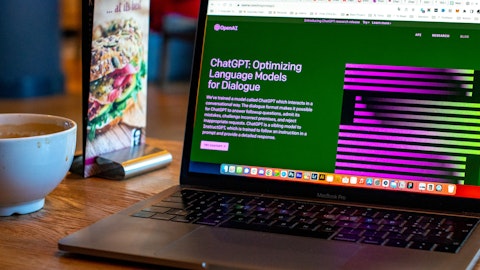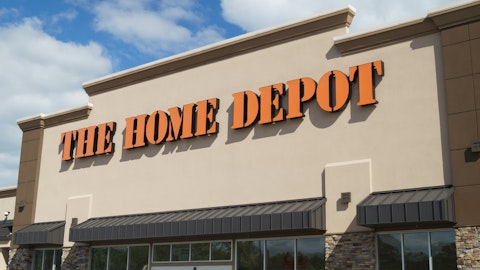Richard McPhail: Chris, thanks for the question. There’s a lot of kind of 2024 conjecture built into that answer. I’ll tell you that — you’re right. So I think when you’re talking about changes in the nature of our labor model, the degree of change in transactions really isn’t material enough to say that changes the nature of our labor model.
Operator: Our next question comes from the line of Michael Lasser with UBS.
Michael Lasser: You talked about the promotional environment discounting being very rational. If the cycle or the downturn for home improvement remains protracted and extended, under what conditions would you expect that discounting will be more intense than it was in 2019 across the industry? And if that were to be the case, would Home Depot choose to remain true to the everyday low price and the portfolio approach that it has or would it look to protect market share and participate in some of that activity?
Edward Decker: We will stay committed to EDLP. And our promotional cadences, as we said earlier, the Black Friday, appliances and gift center and some spring events for seasonal garden items to get traffic in stores, those have been the playbook for years and years, right, Billy, and we don’t see us going away from that. In fact, we’ve stayed truer to reductions of promotions when you think of categories like ceiling fans that I remember was constantly on and off 10% and 20% off. Paint, which was a promotional category, were 5% and 10% and then it went to 10% and 20s, we’ve backed off all of that. And on the margin, we prefer to be even less promotional than we are today. If you had a protracted downturn in the market, I mean, for sure, we’re going to be competitive.
And for sure, we are going to protect our share. But when you think of the nature of large home improvement projects, certainly one done by a pro, the labor component is such a big piece of that job. I mean just take paint, for example. If you’re painting your living room for $500, the paint in that job is going to be less than $100 and it’s your labor bill, either your opportunity cost as a consumer or the pro doing your job for you. So being super aggressive to take $10 off the $100 component of a $500 job I don’t think really moves the needle, and that’s why our bias, our starting position would be no, we wouldn’t chase a lot of price in that dynamic.
Michael Lasser: Got you. Very helpful. My follow-up question is, historically, Home Depot has underpromised and overdelivered in just about all facets. Is it realistic to think that you took the same approach when building this $500 million of net cost savings for next year such that there could be upside to that number?
Richard McPhail: Well, that cost number was really more a function of having built capacity to handle the explosion in our volume during COVID. And then the sort of other side of that pill, where we pulled capacity in many forms back. And so it was the right thing to do regardless of the environment. It does happen to provide a buffer for our operating margin as we move into 2024.
Operator: Our next question comes from the line of Steven Zaccone with Citi.
Steven Zaccone: Congrats on the new role. I wanted to focus on the Pro side of the business. So the commentary about growing with the complex Pro. In the past, there’s been a focus on the flatbed distribution centers and the rollout on a regional basis. Is that still very much the strategy for the next couple of years? And as you zoom out and think about the opportunity with the complex Pro, what are the top priorities within those next 1 to 2 years?
Ann-Marie Campbell: Steven, thank you so much for the kind words there. Chip is in the room, and he has been intimately knowledgeable about that. And so I’m going to throw it over to Chip, and he’ll talk a little bit about some of the capabilities that we continue to leverage and some of the functionalities and capabilities that we will continue to build.
Chip Devine: Yes. Thank you, Steven. We are going to continue certainly our march down to the expansion of our outside sales teams and continue to grow the complex Pro as it was mentioned in the earlier remarks, the connectivity into the store is an important part of this asset build as well. Our Pros shop in our stores every single day and connecting that ecosystem to our flatbed delivery systems is part of that. So as we look and expand into different markets as we move forward from where we currently are, we will continue to evaluate the best opportunity to expand those distribution assets as well to support our growth in Pro.
Steven Zaccone: Okay. I wanted to revisit Simeon’s question about inflection because I know it’s a challenging backdrop to predict. But I guess as you think about the business, what are the key building blocks to take the business from this period of moderation to a more stable market backdrop when you talked about low single-digit market growth? I’m curious if you could opine on, is it really the PCE shift? Is it rates? Just any help you provide would be helpful.





